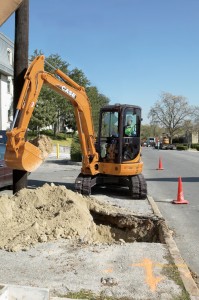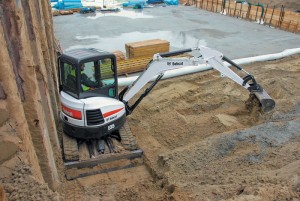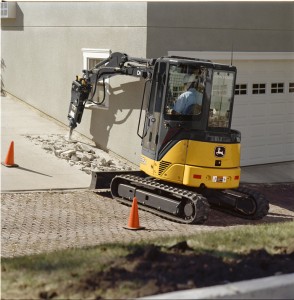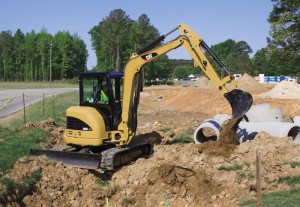February 2011, Vol. 66 No. 2
Features
Compact Excavators Noted For Practicality, Flexibility

It’s hard to believe that a little more than a decade ago, compact excavators were basically unknown in the United States. Long popular in Europe and Asia because their compact size allowed them to work in small areas of large, congested cities, the first Japanese compact excavators that began appearing on American job sites brought curiosity, even amusement, and their potential was not at first recognized.
However, these versatile machines had a feature that sets them apart from other excavation equipment: a pivot point where the boom connects to the vehicle allowing the boom to be positioned for offset trenching. In addition, interchangeable attachments equip a compact loader to do many different jobs.
Rental stores began to carry the machines, providing an opportunity for equipment owners to try them without investing in ownership. The size and versatility of compact excavators soon developed a growing demand and American manufacturers entered the market to compete with imported models.
Excavator “size” typically is defined by operating weight in metric tons (a metric ton is 1,000 kg or 2,205 pounds) with models of one to ten metric tons considered “compact.”
Today, compact excavators routinely are found on many types of construction sites and are widely owned by municipalities and utility companies as well as contractors, including utility contractors.
Bobcat Company, Tom Connor, excavator product specialist: The primary advantages compact excavators provide compared to other types of excavation equipment are boom swing with the capability to do offset trenching and the capability of quickly attaching and removing a broad selection of attachments.
Two sizes of compact excavators are favored by utilities and utility contractors.
Three- and four-ton models are very popular. Weighing 7,000 to 8,000 pounds, they are easy to transport. Their maximum digging depth of 10 feet is sufficient for most utility work, and their reach allows dirt to be positioned away from the hole.
One- and two-ton models are very compact and ideal for refurbishing utilities and replacing aerial cable underground. They can go through 30-inch fence and yard gates, and they can work in small spaces. Boom swing allows working around obstacles and it is possible to dig on both sides of a pedestal without moving the machine. Different bucket sizes can be interchanged so it isn’t necessary to dig more trench than is needed.
For utility work, popular attachments include augers, breakers and clamps, used in conjunction with buckets to remove debris. The variety of buckets is important and users want to be able to change attachments quickly and easily.
There has been a revolution in Bobcat’s line of compact excavators over the past three years with most models incorporating features of our M Series with changes that enhance performance, operator comfort and up time. They bring compact excavators to the next level of sophistication.
New hydraulic systems use engine horsepower more efficiently to do more work while some models burn as much as 20 percent less fuel; pivot points last longer and are easier to maintain; controls are arranged for ease of operation, and ergonomic features make the operator more comfortable. Demand is growing for climate-controlled cabs and other convenience options, and a comfortable operator is a more productive operator.
Compact excavators are popular rental machines. We don’t have hard figures on the actual number of rental machines in the workforce today. During my 20 years in the industry, I’ve seen rental demand come and go, decline, and then come back again.
As popular as compact excavators are, their capabilities are not universally understood
by equipment users. To really understand how effective they can be it is necessary to see them on the job. Renting is a good way to check out a machine, and initially the rental market was a factor in getting machines out and working. We would find renters would rent, like the machines, rent for longer periods, and then decide to buy. That still occurs today.
In economic downturns with workloads uncertain, renting allows contractors to rent the equipment they need and return it when the job is over, avoiding long-term purchase obligations.
Case Construction Equipment, Curtis Goettel, marketing manager: Compact excavators are most often used in traditional backhoe applications (trenching, foundation excavation, patio, sidewalk and hardscape installation, etc).

Compact excavators are economical to operate, and they can fit in places where loader/backhoes and mid-sized excavators can’t. Their rubber tracks (versus wheels) provide very low ground pressure; so they won’t tear up the existing landscapes. Tracks provide the same benefit when operating on dirt, mud and wet areas, whether digging or grading. Their overall versatility allows them to be used in many different applications and operate at low costs per hour during their life cycle.
A compact excavator is typically equipped with a hydraulically-controlled backfill/grader blade for backfilling a trench it has dug. This blade, combined with the unit’s small size and light footprint, make it well suited for grading small areas such as patios, residential lots and new landscape installations.
Compact excavators are ideal for residential utility applications, including digging for new utility installations and excavating existing installations that need repair or replacement. If there is a pipe in the ground that’s leaking, a compact excavator offers pinpoint control in these situations. For new construction, utilities typically will come into the building at one location, but at different depths. The compact excavator can dig a trench for the deepest utility installation, then partially fill the trench for the next installation and so forth until all the utilities are installed.
Contractors appreciate many features of compact excavators. For one, a compact excavator is very portable and can be trailered easily. They provide superior visibility from the cab. They offer the ability to swing the boom without rotating the swinging, which means they can dig in tight quarters and around objects like poles. The compact excavator is a good choice for working on existing landscapes because its rubber tracks don’t disturb the ground.
Contractors use a variety of buckets for utility applications. Also popular is the thumb-clamp attachment that is useful for grabbing objects like pipe sections. Some contractors also use hydraulic hammer attachments for demolition work.
Center-swing boom designs allow for the unit to dig or operate attachments directly parallel to building foundations, fences or other obstacles. Two-speed transmissions give the excavators faster ground speed. Zero-tail-swing designs allow unobstructed operation near obstacles, tree lines and foundations.
Joystick pilot controls and proportional-flow hydraulics on Case compact excavators give smooth and intuitive control of the excavator and any hydraulic attachments, while reducing operator fatigue. Variable controls allow the operator to use either hand to control the bucket or dipper. Case excavators feature a three-post ROPS, instead of four, which improves operator visibility of the work site. It also makes it easier to enter and exit the excavator.
The Case one-touch decelerator allows the operator to tap a button and instantly drop the engine to idle so that they can talk to ground operators. One more touch and the engine returns to the previous RPM level without having to reset it.
The availability of cabs with heat, A/C, radios, heated seats and suspension seats all allow for increased operator comfort, which means they spend more time in the seat working and making money.
We estimate that as many as one-third of all compact excavators are rental units. Rentals are a very important source of business for equipment dealers.
John Deere/Hitachi, Mark Wall, product marketing manager: While compact excavators have been popular in Europe and Japan for many years, North American contractors have only begun to realize the usefulness of the machine in the past 10 years. As a result, compact excavators have enjoyed above average growth in the construction market over the last decade. In the early 2000s, a significant portion of the compact excavator market was in the rental channel, as contractors experimented with the tool in various applications. As contractors discovered the usefulness and increased the utilization, ownership has increased.


Compact excavators are a great tool for the underground utility market. Residential installers have learned that compact excavators are great at trenching in utilities. In addition to compact size and easy transportability, numerous features on compact excavators lend themselves to utility applications, including boom swing for numerous digging angles, especially next to foundations; rubber undercarriage to prevent damage to lawns, asphalt and concrete; zero-tail-swing configuration for digging next to buildings and other surface improvements without damaging the wall or the machine; availability of multiple bucket widths for each situation; an auxiliary hydraulic feature that will enable multiple attachments like, breakers, augers and compactors; and great reliability and productivity.
Three to four metric ton models have become the most popular sizes in North America.

As contractors discovered the versatility of compact excavators and their popularity increased, they requested updates, especially in the area of ease of use. During the last model update, Deere and Hitachi introduced many features into the compact excavator that traditionally had only been found on larger machines. Examples include auto idle to reduce engine RPMs when machine is not in use; auto shifting from low speed to high speed; optional cab with standard heater and A/C, and suspension seats. Models with 131/2 feet digging depths that help increase productivity.
In addition to their versatility, utility contractors demand that compact excavators have smooth, precise controllability, and utility contractors utilize angle blades for back filling trenches.
FOR MORE INFO:
Bobcat, (866) 823-7898, www.bobcat.com
Case Construction, (262) 636-6772, www.casece.com
John Deere, (309) 748-0114, www.johndeere.com
Hitachi Construction, (309) 765-0271, www.hitachiconstruction.com
Caterpillar, (309) 675-1000, www.cat.com




Comments